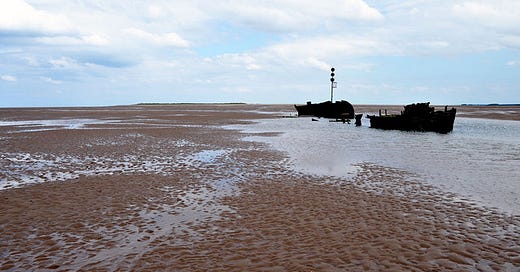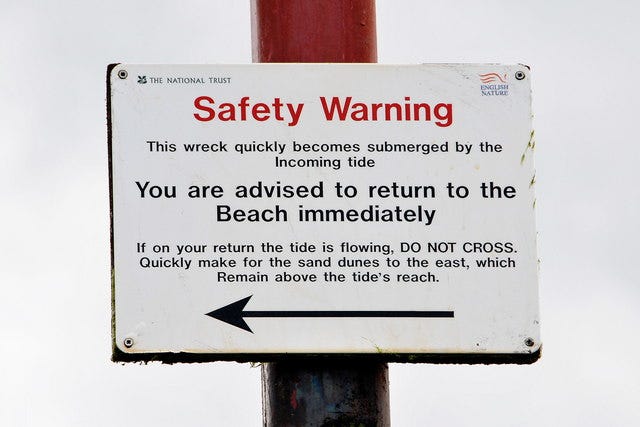In view of the fact that the wreck of the SS Vina, the now, it seems, infamous remants of the one time coaster that made regular trips between Britain’s eastern coast and the ports of the Baltic has made tbe news headlines, yet again, I though it a good time to reimagine an article I wrote about her back in 2019 and post it on Harnser’s Blog today (pic-Julian Dowse/geograph)
___________________________________________________________________________
The romance that surrounds the subject of shipwrecks is undeniable.
It’s place in popular folklore was heightened by the sinking of the RMS Titanic in 1912. A calamitous tale of complacency that led to a seafaring tragedy that had been perceived as impossible.
Titanic became, instantaneously, the definitive shipwreck, a byword for loss on an almost incalculable scale. It’s place in history was reinforced when its last resting place was finally located in 1985. A smash hit film followed in 1997 and, with it, Titanic’s place in popular culture and in the consciousness of anyone who dreams of “...a tall ship and a star to steer her by” forever.
The truth of it is that few people can resist the lure of a shipwreck.
A fact of life that extends even to the shapeless lumps of rusting iron that lie on a sandbank just off the popular beach at Brancaster. Innocuous they might be and yet that flame to the imagination that any shipwreck ignites means that this one remains an irresistible magnet to the curious, unwary and, more often than should be the case, the positively foolhardy.
The remains in question are that of the SS Vina, a coaster ( a shallow hulled ship used for trade between ports, in his case, sailing a route between those on Britain’s east coast and those on the Baltic) that was built by the famous Scottish shipbuilders Ramage and Leith in Leith for J T Salvesen & Co. Ltd.
Coasters were worked very hard and sailed in predominantly rough seas and unforgiving weather so, when Vina was nearing the end of her useful seagoing life in 1940, she was requisitioned by the Royal Navy for wartime use as a blockship (ie) one that is deliberately sunk in order to prevent the ingress of an aggressive enemy force into a key port or harbour.
She was, at the time, one of just three vessels of her type that the owners possessed, the other nine having been lost to enemy U-Boat action. Vina’s ultimate fate therefore, was to be scuttled near the harbour mouth at Great Yarmouth, an action that would have, temporarily at least, delayed any planned Nazi invasion along that part of the coast. With her hold packed with explosives and concrete, Vina was towed into position and left there for four years before, with the threat of invasion abating by the day, she was moved again, this time to the shallow waters off Titchwell (a mile or so to the west of Brancaster) where she was scheduled to be used as target practice for the allied air forces that would be taking place in the invasion of Normandy on D Day in 1944.
Yet Vina, the great survivor, did not want to die such a violent death. Imbued still with the spirit of the sea and with the salt still running through her iron veins, she slipped from her anchorage during a gale on the night of 19/20 August 1944 and ran, adrift and as a sea going vessel, sailed for one final time before running aground in the shallow waters to the west of Scolt Head island which is where she resides to this day.
If you take a trip to Brancaster on a hot summers day in order to enjoy the wide open spaces and skies that this triumph of the Norfolk countryside has to offer, cast a leisurely eye over to Vina’s last resting place and count how many explorers and would be treasure hunters you can see picking over her remains.
On some days the crowds of people gathered out there would be more befitting to Stonehenge rather than Vina’s much more recent remains of which her triple expansion engine is perhaps the most identifiable part.
Hardly treasure and hardly, as it stands, a sight worth losing your life for.
Powerful currents run between the wreck and the beach and there have been instances of unwary sightseers drowning after walking out to take a closer look only to find themselves cut off by the incoming tide….
A warning sign that was affixed to the wreck infrastructure. By the time you got to see and read (hopefully) this, you were already in a very dangerous place (Julian Dowse/geograph)
The wreck is, of course, as much subject to the shifting sands as it is to the twice daily incoming tides-albeit that the former is a slower, less predictable and less deadly process. Thus, in recent times, much of Vina has been covered in sand with only her mast showing above that damp and heavy grave.
But, as the name suggests, the sands come and go and, slowly, parts of the wreck are becoming visible again and, with that, the tempation to wander across the channel to walk amongst her remains will remain.
You might be able to paddle across this outflow channel to get to her. But be warned, you won’t be able to wade or swim across it once you have crossed another Rubicon and left it too long and too late… (Julian Dowse/geograph)
There are warnings at the entrance of the beach advising visitors of the sheer folly of any such notion.
But we are a curious and all too naive species and warnings, after all, are only there to be disregarded.
Or so it would seem it at times.
The SS Vina does, despite her form and shape suggesting she was once anything other than a ship, still have that draw for the unwary and unaware.
But, despite that primordial desire for adventure bubbling up in your veins, its best to let it go and have an ice cream instead.
And gaze upon her from a safe distance.
In other words, the beach.
___________________________________________________________________________
I won’t dwell on the specifics of the recent news story that tells of yet another tragic death on the beach caused by that seemingly insatiable human desire to explore the remains of the SS Vina.
You can find the reports online if you care to look.
But what I will say is, contrary to every single one of those reports I have read in the last few days, the wreck in itself is NOT ‘dangerous’ just as a gun is only ‘dangerous’ if it is in the hands of someone ready and willing to use it.
What is dangerous is how some of us respond to situations where the possibility of loss of life and limb is a very real and present outcome.
And yet still we go.
Drawn by rusted iron and shifting sand, by curiosity, bravado, or the need to touch history with our own hands.
But the sea is not a museum, and the Vina is no exhibit. It is a relic surrounded by peril—silent, unmoving, but framed by tides that do not forgive hesitation or misjudgement.
Admire her, yes.
Learn and remember her life, certainly.
But do not let her claim yours.
________







Interesting and poignant